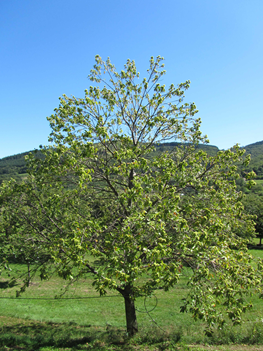
The objectives of this participative research program are:
1: Select surviving European chestnut trees within strong impacted areas by the ink disease
2: Evaluate their resistance against Phytophthora in laboratory, and verify their belonging to sweet chestnut, the species Castanea sativa.
3: Use the individuals showing the best resistance capacities against ink disease (“elite trees”) as seeds producers in seed orchards.
The expected results are:
- Reconquest and renewal of the actually declining chestnut orchards
- Decrease of production cost due to nuersery seedling production.
- Higher genetic diversity in the chestnut plantations.
Ink disease, caused by a root pathogen (P. cinnamomi, P. cambivora) induces dieback and mortality in sweet chestnut, C. sativa. It is an obstacle to the orchard and forest renewal.
In France, ink disease resistant hybrids rootstock have been selected by INRA, but they are not adapted to Mediterranean chestnut orchards. In this region, there is a strong demand from the sector to find new rootstocks from C. sativa for which there is a significant variability on ink disease sensibility in several provenances or varieties, in the forest population of the European Atlantic area, abd within the contaminated orchards.
The project was participative and involved the chestnut sector. It has been initiated in partnership with the chestnut associations union in Languedoc-Roussillon (ULRAC), the regional chamber of agriculture of Occitanie, the chamber of agriculture of Ardèche and the interprofessional technical centre for fruits and vegetables (CTIFL).
The main results are:
- Identification of asymptomatic rootstocks in infested parcels
- Selection of the most resistant trees (five years of laboratory tests)
- Multiplication of selected trees by cutting
- Molecular taxonomic classification (they all belong to C. sativa specie)
- Installation of seed orchards
Reported trees in infected sites can concern wild chestnut on which local varieties have been grafted or seedlings from natural regeneration. Laboratory tests must be anticipated and done at the right phenological stage and have to be repeated several years or on multiple copies.
The tests to confirm resistance of trees selected as survivors are more reliable if they are done on vegetative copies of these trees. Previously, selected trees must multiplied by grafting. This step is used to have vegetal material to produce plants of this selection on their own roots (cutting and micro-propagation) in order to do resistance tests not on cuttings but on root systems. It also permits to ensure preservation of the selected individuals.
Participants of this program can use the smartphone application Vigil’encre and benefit from the associate data base. Many types of stakeholders can participate in this research program: citizens, chestnut sector stakeholders, research and technical institutes.
The frequency of resistant trees in the populations studied is difficult to estimate, and may therefore be low. The number of participants should help to overcome this difficulty.
The selection of resistant trees in new territories, such as Corsica, and other types of chestnut groves is being studied in order to increase the number of genotypes in the G0 population of this participatory selection programme.
All the results obtained converge to confirm that ink resistance in Castanea sp. is partial, quantitative and heritable. The creation of a seed orchard composed of these C. sativa trees selected for their ink resistance will permit to obtain offspring with a high level of resistance while being adapted to local environmental conditions.
Further information
Decourcelle et al. 2004. Chestnut wild populations genetic diversity and susceptibility to ink disease in Atlantic Pyrenees and Navarra. Third International ChestnutCongress, Chaves, Portugal.
Ramos Guedes-Lafargue et al. 2005. Evaluation of INRA Chestnut Interspecific Hybrids. Acta Horticulturae, 693: 321-324.
Robin et al. 2006 Genetic variation in susceptibility to Phytophthora cambivora in European chestnut (Castanea sativa). Forest Ecology Management 226: 199-207.
Saintonge, 2005. En 2003 et 2004, l'encre et le chancre du châtaignier restent d'actualité. Département de la santé des forêts - Bilan de la santé des forêts en 2004
https://play.google.com/store/apps/details?id=com.inra
INRAE

Helina Deplaude - Chambre d'agriculture d'Ardèche
